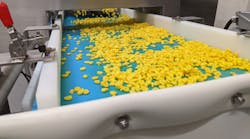When consumers started raiding grocery store shelves last March in the face of COVID, many food processors saw demand for certain products spike. Packages of comfort foods, for example, flew off the shelves faster than they could be restocked. In many cases manufacturers could not keep up with orders.
Fortunately, contract manufacturers were able to pick up the slack.
“Regarding food for consumer use at home, we saw massive growth. Our members ramped up production, especially on the big bulk stuff,” says Ron Puvak, executive director of CPA: The Association for Contract Packagers & Manufacturers. “We can pivot quicker than the brands.”
Retail business booming
The fact that consumers bought more food at the grocery store in 2020 is not surprising given the circumstances, but the numbers are still impressive: According to IRI POS scanner data, dollar sales of retail pizza products were up 43 percent over 2019; Asian food products climbed 35 percent; and spices and seasonings jumped 32 percent, for example.
That put a lot of demand pressure on food processors … much of which meant growing sales for contract manufacturers.
“We all benefited from a significant increase in demand for consumer packaged foods – particularly products that are comfort foods, add flavor and variety or offer convenience,” says Paul Whitaker, director of consumer product sales for Wixon.
“During the pandemic, a high portion of meals were being prepared at home, and demand for consumer-sized packages stretched most manufacturers to capacity," he continues. "This led to outsourcing through contract manufacturing partners, which in turn pushed most contract manufacturers to expand capacity to meet current business – plus the new opportunities presented with the overall increase in demand.”
Wolfgang Buehler, owner of Organic Milling, says his company saw tremendous increase in demand for its keto-diet-friendly products such as granola made without oats. Such products offered consumers the eating satisfaction they wanted during lock-downs, but with fewer carbs.
“We experienced tremendous volume increase from all categories. It was quite a ride,” Buehler says, adding that sales climbed 50% over 2019. “We were able to quickly optimize and commercialize these keto-friendly items and get them on the shelves. What typically takes a full year, on some of the SKUs what we started in May we were able to get fully commercialized by September.”
And once those new products hit the shelves, they moved quicky, Buehler says.
“Orders were going from 50 pallets to 700 pallets all of the sudden,” he says. “And obviously the consumer took it off the shelf. And these are not inexpensive items.”
Of course, not all segments of food production increased during COVID. Products created for foodservice, for example, took a massive hit. The National Restaurant Assn. reported foodservice sales in 2020 were $270 billion below expected levels. That meant co-manufacturers in that space lost business.
Puvak confirms that CPA members who serve the foodservice market were especially hard hit. Those co-manufacturers had to seek new markets for those products.
“If you were in foodservice, your business dried up,” he says. “I had a lot of people scrambling, asking me how to convert food service packaging to single serving.”
Chuck Metzger, CEO of the biggest contract manufacturer Hearthside Food Solutions, says his firm was impacted by the decline in restaurant business, but the retail side of Hearthside’s business balanced that out.
"Parts of our business definitely saw a positive impact because of the consumer dynamics of staying home and online shopping,” Metzger says. “There were particular product lines that saw very large increases in demand. In some cases, our existing customers saw a huge spike, and in other cases new customers came to us because they needed instantaneous capacity. Since we have a broad range of capabilities, we were able to bring on that capacity in a rapid fashion.”
Ingredient, packaging issues
The surge of business brought on by COVID was accompanied by several production issues, including difficulty procuring ingredients and packaging supplies.
For example, Buehler says the increased demand for his company’s granola – which is made with an assortment of fruits and nuts – pressured the supply of those ingredients. This was exacerbated by overall problems with shipping during COVID.
General Mills Plans To Wind Down Co-Manufacturers
General Mills, which recruited some 50 new contract manufacturers during the pandemic, will drastically reduce that number once pandemic-driven demand for its products tapers off, the CFO said in April.
With a large portfolio of shelf-stable, pantry items with trusted brand names, the Minneapolis-based company benefitted from the pandemic. Sales for the final six months of 2020 were up nearly 8% from the same period in 2019, and the company needed 50 new contract manufacturers to meet the increased demand – on top of about 200 contract manufacturers that had been on board before the pandemic.
CFO Kofi Bruce told the Wall Street Journal in April General Mills is planning for the return to normal consumption patterns. He believes consumer demand will remain robust, higher than before the pandemic: “I don’t think our new normal is the old normal,” he told the Journal.
Nevertheless, when that happens the company will quickly reduce its orders from contract manufacturers. Such additional production typically costs more and shaves off between 10% to 15% of a product’s gross margin, said the Journal, quoting analysts.
It's likely other food and beverage processors are contemplating similar steps.
“The ingredient issue is a constant battle,” he says. “When we were increasing the volume of products that contain fruits and nuts, we had some issues just getting the ingredients out of the port. The port was nearly locked down because of COVID.
"We’ve had to delay some complete orders, but not cut any back. We added some new team members in sourcing and I’m glad we did. They have their hands full.”
In contrast, Metzger says Hearthside, which has 37 facilities worldwide, did not experience particularly difficult supply or shipping issues. He says there were moments when shipping got tighter, especially during the COVID spikes, but not critically so.
“I would characterize it as spot issues,” Metzger says. “I would say the disruption in supply chain was not more or less than you normally see. When you have a supply chain as complex and broad as we have, you get spot situations going on in any given week or month on a normal basis.”
Finding packaging supplies was one issue that Wixon faced, Whitaker says. For example, packaging suppliers who also serve the healthcare industry – and needed to facilitate the ramp-up in hand sanitizer packaging – had to prioritize supply availability.
“Packaging – particularly rigid packaging – became more difficult to source as demand increased significantly for the resins,” Whitaker says. “Lead-times became extended for primary suppliers. Secondary suppliers were leveraged, and in some cases, alternate packaging solutions were developed and rushed to market.”
COVID & Co-Manufacturers
Of course, contract manufacturers had to deal with COVID itself, just like every other manufacturer, which led to some staffing issues.
“Probably the most complex issue to manage has been labor,” Whitaker says. “Typically, contract manufacturers flex up to meet demand with temporary labor. With COVID, we had new dimensions to consider to manage the safety of our employees in production areas.”
Wixon introduced multi-shift operations to spread out workers and instituted new sanitation procedures and screening protocols, for example.
Buehler says he started implementing COVID safety measures at Organic Milling as soon as the World Health Organization issued guidelines in March 2020. By mid-March, all 150 employees were required to wear masks, and social distancing rules were in place, such as only two employees allowed at each lunchroom table.
The company also extended sick pay to 80 hours, because Buehler knew that if someone tested positive, he or she would need to be out for two weeks. In December the company started regularly testing every employee and required any who tested positive to stay home. The efforts have paid off.
“At the end of the day, no one has had to stay home for more than two weeks,” he says. “And since the first week of February we’ve had zero new cases.”
Hearthside also sprang into a protective posture as soon as COVID hit, Metzger says. For example, plastic barriers were installed between all close workers, a tremendous undertaking for a company with 11,400 employees around the world.
“We pivoted our engineering organization to that activity and brought in outside contractors,” Metzger explains. “We set a goal to have all the barriers in place in two weeks, and we more or less got there. We also moved the office staff to remote work and got everyone a PC. It was a massive sense of urgency by this organization.”
Power Brands also worked to keep employees safe, says CEO Darin Ezra. “Social distancing forced us to limit how many people could be in the lab and how many clients could visit at one time. We implemented mandatory testing before a company could visit.”
Keeping existing employees safe was a key issue, of course. But labor issues also extended to recruitment, since so many co-manufacturers needed more staff to handle the extra work. As Whitaker noted, co-manufacturers have long relied on temporary labor to meet sudden personnel demands. But for a variety of reasons, ranging from worries about safety to child-care concerns with schools being closed, temporary laborers have been in short supply.
“Competition for labor, permanent and temporary, has been fierce,” Whitaker says. “We have created programs and incentives to attract and keep great employees, including recruiting and sign-on bonuses, as well as loyalty and productivity incentives.”
Will the surge in business last?
The increase in co-manufacturing business during COVID has helped the bottom line of those companies, but will the new business last? The predictions are mixed.
“That chapter of this whole situation is yet to be written,” Metzger says. “I think you’ll see some positive impacts in some parts of our business, but generally speaking we would expect in many cases they would return to normal. As we talk to our customers, there’s a mixed perception about where they think their businesses are going to go.”
Buehler is more confident: “The momentum that came in the second half of 2020 is carrying into 2021, and we’re very comfortable that it will last more than through 2021 because of the new partnerships that were formed.”
Puvak says that the experiences during COVID may accelerate a business development trend that is otherwise unrelated to the virus: brand owners deciding that they don’t need to be manufacturers, too.
“The brands are rethinking their supply chains,” Puvak says. “They’ve seen how thin and vulnerable their supply chains can be, so I think you’re seeing more strategic discussion on that issue.
"The sense I get from our members is that they don’t expect to lose the new business they’ve received," Puvak concludes. "They expect it will maintain and grow, and they’ve been told that by their partners.”

